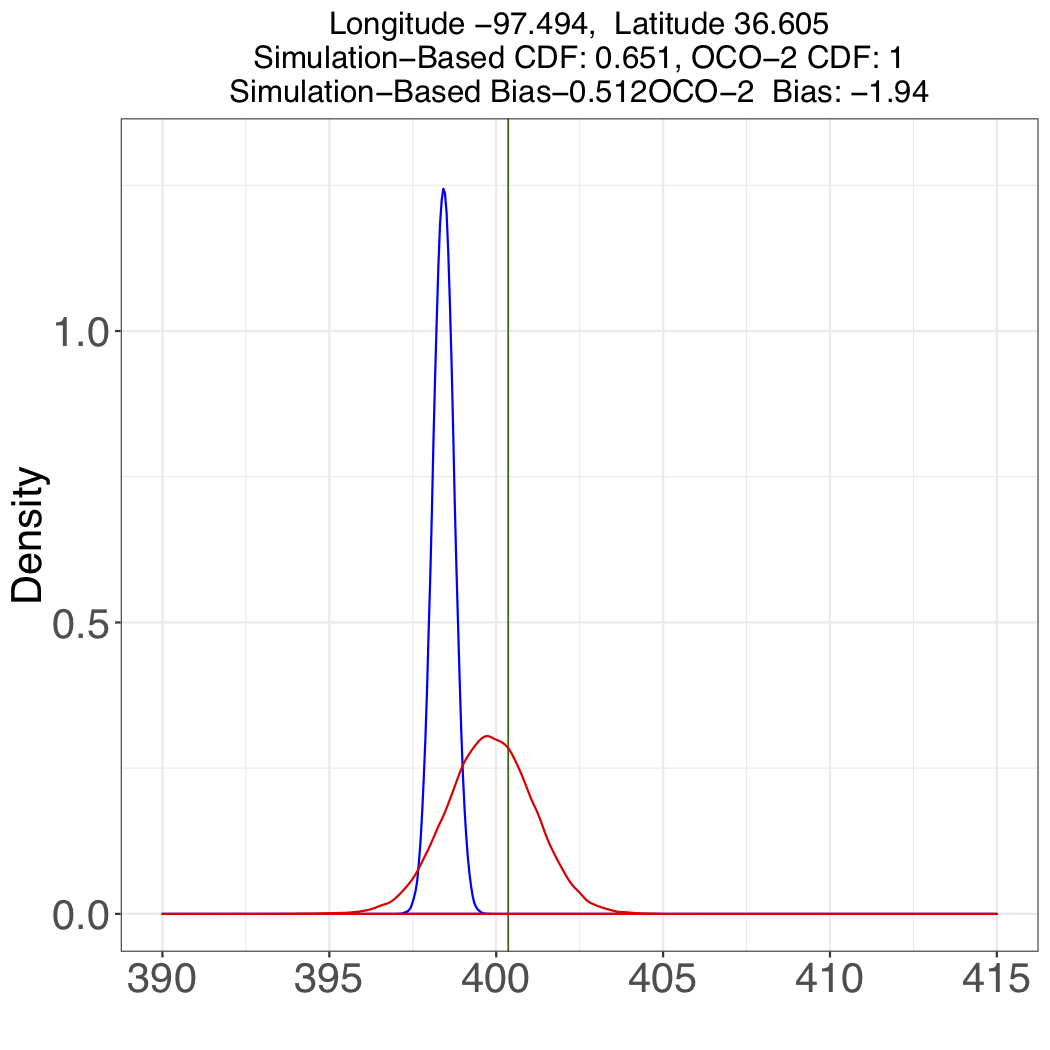Projects
Uncertainty Quantification for OCO-2
Our approach for OCO-2 is simulation-based uncertainty quantification. This means that we create ensembles of synthetic true state vectors, and use them drive a Monte-Carlo experiment that provides a corresponding ensemble of retrieved state vector estimates. Elements of these two ensembles are paired, resulting in a joint sample that we use to model the relationship between the true state and its retrieved counterpart. We fit a statistical model to the joint sample, and derive regression-style equations to predict the distribution of the true state given the retrieved estimate. Then, when we receive an actual OCO-2 retrieval from the mission's data processing chain, we plug it in to the predictor to obtain the distribution of the true state as a function of the estimated state.

|

|
| Comparison among simulation-based pdf (red), retrieved pdf (blue), and true CO\(_2\) concentration (green) for one OCO-2 footprint at Lamont, OK. | Comparison among simulation-based pdf (red), retrieved pdf (blue), and true CO\(_2\) concentration (green) for one OCO-2 footprint at Tsukba, Japan. |
Selected Publications
Patil, P., Kuusela, M., and Hobbs, J. (2022). “Objective frequentist uncertainty quantification for atmospheric CO₂ retrievals,” SIAM/ASA Journal on Uncertainty Quantification, 10(3), pp. 827–859. Document (link to DOI).
Braverman, A., Hobbs, J., Teixeira, J., and Gunson, M. (2021). “Post hoc uncertainty quantification for remote sensing observing systems,” SIAM/ASA Journal on Uncertainty Quantification, 9(3), pp. 1064–1093. Document (link to DOI) (CL 21-0606).
Hobbs, J. M., Drouin, B. J., Oyafuso, F., Payne, V. H., Gunson, M. R. and others (2020). “Spectroscopic uncertainty impacts on OCO-2/3 retrievals of XCO2,” Journal of Quantitative Spectroscopy and Radiative Transfer, 257, p. 107360. Document (link to DOI) (CL 20-5165).
Lamminpää, O., Hobbs, J., Brynjarsdóttir, J., Laine, M., Braverman, A. and others (2019). “Accelerated MCMC for satellite-based measurements of atmospheric CO₂,” Remote Sensing, 11(17), p. 2061. Document (link to DOI).
Nguyen, H., Cressie, N., and Hobbs, J. (2019). “Sensitivity of optimal estimation satellite retrievals to misspecification of the prior mean and covariance, with application to OCO-2 retrievals,” Remote Sensing, 11(23), p. 2770. Document (link to DOI).
Hobbs, J., Braverman, A., Cressie, N., Granat, R., and Gunson, M. (2017). “Simulation-based uncertainty quantification for estimating atmospheric CO₂ from satellite data,” SIAM/ASA Journal on Uncertainty Quantification, 5(1), pp. 956–985. Document (link to DOI) (CL 17-2675).
Connor, B., Bösch, H., McDuffie, J., Taylor, T., Fu, D. and others (2016). “Quantification of uncertainties in OCO-2 measurements of XCO2: simulations and linear error analysis,” Atmospheric Measurement Techniques, 9(10), pp. 5227–5238. Document (link to DOI).
